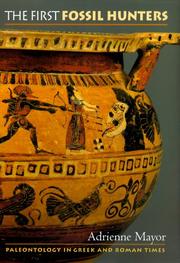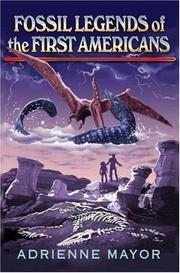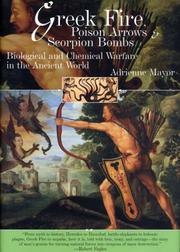| Listing 1 - 10 of 25 | << page >> |
Sort by
|

ISBN: 0691089779 0691058636 Year: 2001 Publisher: Princeton Princeton University Press
Abstract | Keywords | Export | Availability | Bookmark
 Loading...
Loading...Choose an application
- Reference Manager
- EndNote
- RefWorks (Direct export to RefWorks)
Antieke wetenschap --- Science [Ancient ] --- Science de l'antiquité --- Wetenschap [Antieke ] --- Wetenschap van de Oudheid --- Paleontology --- Science, Ancient --- Fossilogy --- Fossilology --- Palaeontology --- Paleontology, Zoological --- Paleozoology --- Historical geology --- Zoology --- Fossils --- Prehistoric animals in motion pictures --- Ancient science --- Science, Primitive --- Science --- History --- Science, Ancient. --- History. --- Paléontologie --- Sciences anciennes --- Histoire --- Greece --- Rome
Book
ISBN: 9780691150130 0691150133 9786613227416 1400838444 128322741X 9781400838448 9781283227414 Year: 2011 Publisher: Princeton, NJ
Abstract | Keywords | Export | Availability | Bookmark
 Loading...
Loading...Choose an application
- Reference Manager
- EndNote
- RefWorks (Direct export to RefWorks)
Griffins, Cyclopes, Monsters, and Giants--these fabulous creatures of classical mythology continue to live in the modern imagination through the vivid accounts that have come down to us from the ancient Greeks and Romans. But what if these beings were more than merely fictions? What if monstrous creatures once roamed the earth in the very places where their legends first arose? This is the arresting and original thesis that Adrienne Mayor explores in The First Fossil Hunters. Through careful research and meticulous documentation, she convincingly shows that many of the giants and monsters of myth did have a basis in fact--in the enormous bones of long-extinct species that were once abundant in the lands of the Greeks and Romans. As Mayor shows, the Greeks and Romans were well aware that a different breed of creatures once inhabited their lands. They frequently encountered the fossilized bones of these primeval beings, and they developed sophisticated concepts to explain the fossil evidence, concepts that were expressed in mythological stories. The legend of the gold-guarding griffin, for example, sprang from tales first told by Scythian gold-miners, who, passing through the Gobi Desert at the foot of the Altai Mountains, encountered the skeletons of Protoceratops and other dinosaurs that littered the ground. Like their modern counterparts, the ancient fossil hunters collected and measured impressive petrified remains and displayed them in temples and museums; they attempted to reconstruct the appearance of these prehistoric creatures and to explain their extinction. Long thought to be fantasy, the remarkably detailed and perceptive Greek and Roman accounts of giant bone finds were actually based on solid paleontological facts. By reading these neglected narratives for the first time in the light of modern scientific discoveries, Adrienne Mayor illuminates a lost world of ancient paleontology.
Paleontology --- Science, Ancient. --- Vertebrates, Fossil --- History. --- Paleontology - Greece - History. --- Paleontology -- Greece -- History. --- Paleontology - Rome - History. --- Paleontology -- Rome -- History. --- Science, Ancient --- Geology --- Earth & Environmental Sciences --- History --- Ancient science --- Science, Primitive --- Fossilogy --- Fossilology --- Palaeontology --- Paleontology, Zoological --- Paleozoology --- Historical geology --- Zoology --- Fossils --- Prehistoric animals in motion pictures --- Science

ISBN: 0691130493 1299993451 0691113459 1400849314 9781400849314 9780691130491 0691245614 9780691245614 9780691113456 Year: 2005 Publisher: Princeton, New Jersey : Princeton University Press,
Abstract | Keywords | Export | Availability | Bookmark
 Loading...
Loading...Choose an application
- Reference Manager
- EndNote
- RefWorks (Direct export to RefWorks)
The burnt-red badlands of Montana's Hell Creek are a vast graveyard of the Cretaceous dinosaurs that lived 68 million years ago. Those hills were, much later, also home to the Sioux, the Crows, and the Blackfeet, the first people to encounter the dinosaur fossils exposed by the elements. What did Native Americans make of these stone skeletons, and how did they explain the teeth and claws of gargantuan animals no one had seen alive? Did they speculate about their deaths? Did they collect fossils? Beginning in the East, with its Ice Age monsters, and ending in the West, where dinosaurs lived and died, this richly illustrated and elegantly written book examines the discoveries of enormous bones and uses of fossils for medicine, hunting magic, and spells. Well before Columbus, Native Americans observed the mysterious petrified remains of extinct creatures and sought to understand their transformation to stone. In perceptive creation stories, they visualized the remains of extinct mammoths, dinosaurs, pterosaurs, and marine creatures as Monster Bears, Giant Lizards, Thunder Birds, and Water Monsters. Their insights, some so sophisticated that they anticipate modern scientific theories, were passed down in oral histories over many centuries. Drawing on historical sources, archaeology, traditional accounts, and extensive personal interviews, Adrienne Mayor takes us from Aztec and Inca fossil tales to the traditions of the Iroquois, Navajos, Apaches, Cheyennes, and Pawnees. Fossil Legends of the First Americans represents a major step forward in our understanding of how humans made sense of fossils before evolutionary theory developed.
Fossiles --- Human paleontology --- Fossilogy --- Fossilology --- Paleontology, Zoological --- Paleozoology --- Paleoanthropology --- Paleontology --- Tales --- Fossils --- Indians --- Anthropology, Prehistoric --- Physical anthropology --- Fossil hominids --- Palaeontology --- Historical geology --- Zoology --- Prehistoric animals in motion pictures --- Antiquities, Prehistoric --- Archaeology --- History. --- Antiquities. --- America --- Indiens d'Amérique --- Contes --- Paléontologie --- Folklore --- Antiquités --- Amérique --- Civilization --- Civilisation --- Indian antiquities --- Indian artifacts

ISBN: 158567608X 158567348X 0715633651 Year: 2003 Publisher: Woodstock Overlook Duckworth
Abstract | Keywords | Export | Availability | Bookmark
 Loading...
Loading...Choose an application
- Reference Manager
- EndNote
- RefWorks (Direct export to RefWorks)
Polemology --- Antiquity
Book
ISBN: 9780691183510 0691183511 0691185441 0691202265 Year: 2018 Publisher: Lawrenceville : Princeton University Press,
Abstract | Keywords | Export | Availability | Bookmark
 Loading...
Loading...Choose an application
- Reference Manager
- EndNote
- RefWorks (Direct export to RefWorks)
The first robot to walk the earth was a bronze giant called Talos. This wondrous machine was created not by MIT Robotics Lab, but by Hephaestus, the Greek god of invention. More than 2,500 years ago, long before medieval automata, and centuries before technology made self-moving devices possible, Greek mythology was exploring ideas about creating artificial life--and grappling with still-unresolved ethical concerns about biotechne, "life through craft." In this compelling, richly illustrated book, Adrienne Mayor tells the fascinating story of how ancient Greek, Roman, Indian, and Chinese myths envisioned artificial life, automata, self-moving devices, and human enhancements--and how these visions relate to and reflect the ancient invention of real animated machines. As early as Homer, Greeks were imagining robotic servants, animated statues, and even ancient versions of Artificial Intelligence, while in Indian legend, Buddha's precious relics were defended by robot warriors copied from Greco-Roman designs for real automata. Mythic automata appear in tales about Jason and the Argonauts, Medea, Daedalus, Prometheus, and Pandora, and many of these machines are described as being built with the same materials and methods that human artisans used to make tools and statues. And, indeed, many sophisticated animated devices were actually built in antiquity, reaching a climax with the creation of a host of automata in the ancient city of learning, Alexandria, the original Silicon Valley.
Robots --- Robotics --- Science, Ancient --- Patents --- History --- Mythology --- Science, Ancient. --- Science and civilization. --- Technology --- Inventions --- Technology and civilization. --- Artificial intelligence --- Robotics. --- History. --- Mythology. --- Religious aspects. --- Social aspects. --- Technology. --- Inventions. --- Artificial intelligence. --- Rome (Empire). --- Greece. --- Robots - Patents - Abstracts --- Robotics - History --- Robots - Mythology --- Robots. --- Antiquities.
Book
ISBN: 9780691126838 0691126836 9781400833429 1400833426 1282608207 9781282608207 9786612608209 661260820X 0691150265 Year: 2009 Publisher: Princeton : Princeton University Press,
Abstract | Keywords | Export | Availability | Bookmark
 Loading...
Loading...Choose an application
- Reference Manager
- EndNote
- RefWorks (Direct export to RefWorks)
Machiavelli praised his military genius. European royalty sought out his secret elixir against poison. His life inspired Mozart's first opera, while for centuries poets and playwrights recited bloody, romantic tales of his victories, defeats, intrigues, concubines, and mysterious death. But until now no modern historian has recounted the full story of Mithradates, the ruthless king and visionary rebel who challenged the power of Rome in the first century BC. In this richly illustrated book--the first biography of Mithradates in fifty years--Adrienne Mayor combines a storyteller's gifts with the most recent archaeological and scientific discoveries to tell the tale of Mithradates as it has never been told before. The Poison King describes a life brimming with spectacle and excitement. Claiming Alexander the Great and Darius of Persia as ancestors, Mithradates inherited a wealthy Black Sea kingdom at age fourteen after his mother poisoned his father. He fled into exile and returned in triumph to become a ruler of superb intelligence and fierce ambition. Hailed as a savior by his followers and feared as a second Hannibal by his enemies, he envisioned a grand Eastern empire to rival Rome. After massacring eighty thousand Roman citizens in 88 BC, he seized Greece and modern-day Turkey. Fighting some of the most spectacular battles in ancient history, he dragged Rome into a long round of wars and threatened to invade Italy itself. His uncanny ability to elude capture and surge back after devastating losses unnerved the Romans, while his mastery of poisons allowed him to foil assassination attempts and eliminate rivals. The Poison King is a gripping account of one of Rome's most relentless but least understood foes.Some images inside the book are unavailable due to digital copyright restrictions.
Poisoning --- Empoisonnement --- Political aspects --- Aspect politique --- Mithridates --- Pontus --- Rome --- Mediterranean Region --- Black Sea Region --- Pont (Région ancienne) --- Méditerranée, Région de la --- Noire, Région de la mer --- Kings and rulers --- Biography --- History. --- History --- History, Military. --- Rois et souverains --- Biographies --- Histoire --- Histoire militaire --- Empoisonnement (Droit pénal) --- Mithridate --- Pont (Région ancienne) --- Méditerranée, Région de la --- Noire, Région de la mer --- History, Military --- Toxicological emergencies --- Toxicology --- Political aspects&delete& --- Mithradatēs, --- Mithradates --- Mithridates, --- Mithridatos --- Mitridat Evpator, --- Mitridate Eupatore, --- Mitridate --- Mitrydat --- Circum-Mediterranean countries --- Mediterranean Area --- Mediterranean countries --- Mediterranean Sea Region --- Poisoning - Political aspects - Rome - History --- Empoisonnement (Droit pénal) - Aspect politique - Rome - Histoire --- Rois et souverains - Pont (Région ancienne) - Biographies --- Mithridates - VI Eupator, - King of Pontus, - ca. 132-63 B.C. --- Mithridate - VI Eupator, - roi du Pont, - ca 132-63 av. J.-C. --- Pontus - Kings and rulers - Biography --- Pontus - History --- Rome - History - Mithridatic Wars, 88-63 B.C. --- Black Sea Region - History, Military --- Mediterranean Region - History, Military --- Pont (Région ancienne) - Histoire --- Rome - Histoire - 88-63 av. J.-C. (Guerres contre Mithridate) --- Méditerranée, Région de la - Histoire militaire --- Noire, Région de la mer - Histoire militaire --- Mithridate (roi du Pont ; 0132?-0063 av. J.-C.) --- Intoxication --- Méditerranée (région) --- Mer Noire (région) --- Antiquité --- Biography. --- Méditerranée (région) --- Mer Noire (région) --- Antiquité
Book
Year: 2020 Publisher: Darmstadt wbg Edition
Abstract | Keywords | Export | Availability | Bookmark
 Loading...
Loading...Choose an application
- Reference Manager
- EndNote
- RefWorks (Direct export to RefWorks)
Comparative religion --- Manufacturing technologies --- History of civilization
Book
ISBN: 9780691211183 9780691217826 0691217823 0691211183 Year: 2022 Publisher: Princeton : Princeton University Press,
Abstract | Keywords | Export | Availability | Bookmark
 Loading...
Loading...Choose an application
- Reference Manager
- EndNote
- RefWorks (Direct export to RefWorks)
"A collection of short pieces by historian of myth and science, Adrienne Mayor, on a wide array of fascinating and fun classical myths and the reality which often lies behind them"-- "A treasury of astonishing mythic marvels-and the surprising truths behind them. Adrienne Mayor is renowned for exploring the borders of history, science, archaeology, anthropology, and popular knowledge to find historical realities and scientific insights-glimmering, long-buried nuggets of truth--embedded in myth, legends, and folklore. Combing through ancient texts and obscure sources, she has spent decades prospecting for intriguing wonders and marvels, historical mysteries, diverting anecdotes, and hidden gems from antiquity, medieval, and modern times. Flying Snakes and Griffin Claws is a treasury of fifty of her most amazing and amusing discoveries.The book explores such subjects as how mirages inspired legends of cities in the sky; the true identity of winged serpents in ancient Egypt; how ghost ships led to the discovery of the Gulf Stream; and the beauty secrets of ancient Amazons. Other pieces examine Arthur Conan Doyle's sea serpent and Geronimo's dragon; Flaubert's obsession with ancient Carthage; ancient tattooing practices; and the strange relationship between wine goblets and women's breasts since the times of Helen of Troy and Marie Antoinette. And there's much, much more. Showcasing Mayor's trademark passion not to demythologize myths, but to uncover the fascinating truths buried beneath them, Flying Snakes and Griffin Claws is a wonder cabinet of delightful curiosities"--
Mythology, Classical. --- Curiosities and wonders. --- Folklore --- Curiosities and wonders
Book
ISBN: 9780691211084 9780691217819 Year: 2022 Publisher: Princeton : Princeton University Press,
Abstract | Keywords | Export | Availability | Bookmark
 Loading...
Loading...Choose an application
- Reference Manager
- EndNote
- RefWorks (Direct export to RefWorks)
"A history of the ways in which ancient cultures developed and used biological, chemical, and other unconventional warfare, drawing on myth, science, and history and told Mayor's scrupulous, yet entertaining style"--
Biological weapons --- Chemical weapons --- Weapons, Ancient. --- Military history, Ancient. --- Military art and science --- History
Book
ISBN: 9780691185446 0691185441 Year: 2018 Publisher: Lawrenceville : Princeton University Press,
Abstract | Keywords | Export | Availability | Bookmark
 Loading...
Loading...Choose an application
- Reference Manager
- EndNote
- RefWorks (Direct export to RefWorks)
The first robot to walk the earth was a bronze giant called Talos. This wondrous machine was created not by MIT Robotics Lab, but by Hephaestus, the Greek god of invention. More than 2,500 years ago, long before medieval automata, and centuries before technology made self-moving devices possible, Greek mythology was exploring ideas about creating artificial life--and grappling with still-unresolved ethical concerns about biotechne, "life through craft." In this compelling, richly illustrated book, Adrienne Mayor tells the fascinating story of how ancient Greek, Roman, Indian, and Chinese myths envisioned artificial life, automata, self-moving devices, and human enhancements--and how these visions relate to and reflect the ancient invention of real animated machines. As early as Homer, Greeks were imagining robotic servants, animated statues, and even ancient versions of Artificial Intelligence, while in Indian legend, Buddha's precious relics were defended by robot warriors copied from Greco-Roman designs for real automata. Mythic automata appear in tales about Jason and the Argonauts, Medea, Daedalus, Prometheus, and Pandora, and many of these machines are described as being built with the same materials and methods that human artisans used to make tools and statues. And, indeed, many sophisticated animated devices were actually built in antiquity, reaching a climax with the creation of a host of automata in the ancient city of learning, Alexandria, the original Silicon Valley.
Robots. --- Technology --- Technology --- Technology --- Mythology. --- Antiquities. --- Artificial intelligence. --- Artificial intelligence --- Artificial intelligence --- Technology and civilization. --- Inventions --- Science and civilization. --- History. --- History. --- History. --- History. --- Social aspects. --- History.
| Listing 1 - 10 of 25 | << page >> |
Sort by
|

 Search
Search Feedback
Feedback About UniCat
About UniCat  Help
Help News
News